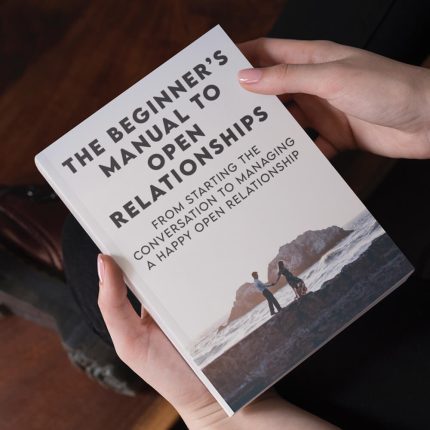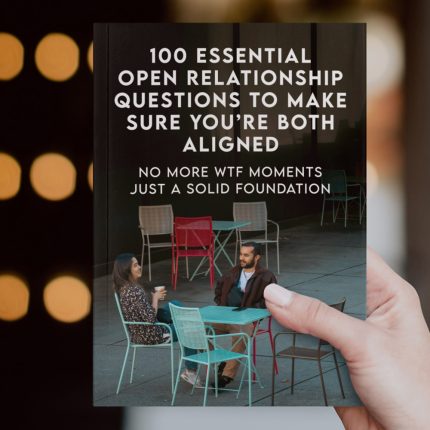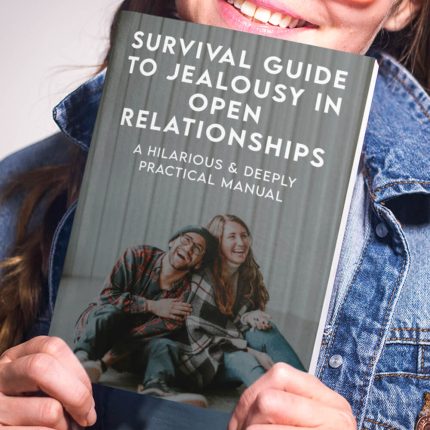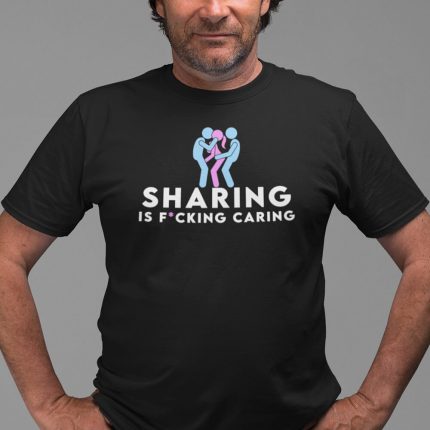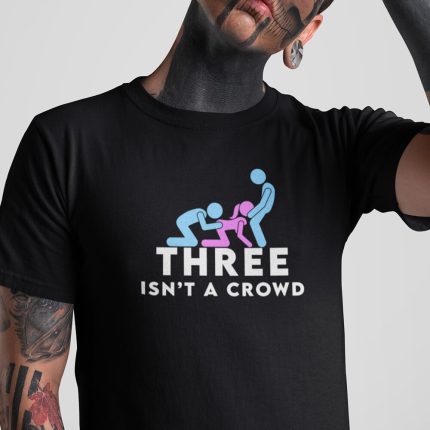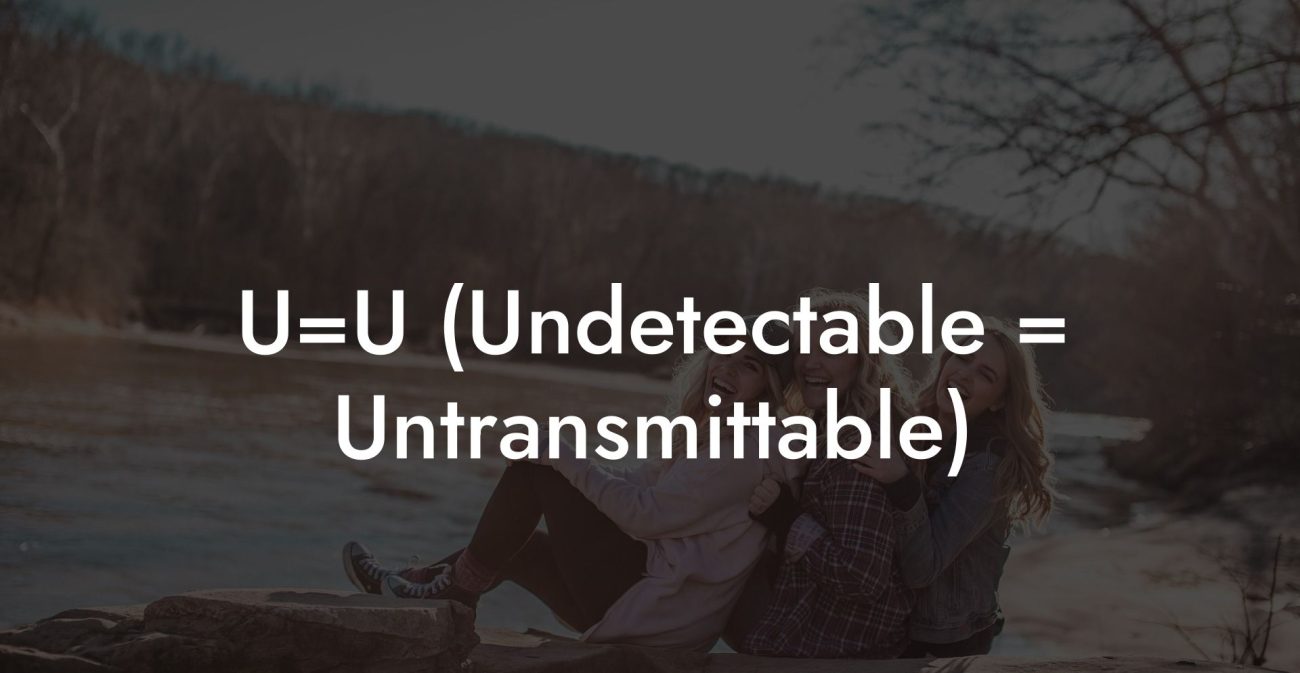Radical Transparency

Imagine a relationship where secrets are replaced by honesty, where every thought and feeling is laid out in the open, and where vulnerability isn’t a weakness but a badge of honor. Welcome to Radical Transparency, a transformative concept in ethical non monogamy that champions the practice of complete openness and authenticity. In this model, every partner is encouraged to share their true self—no filters, no omissions—creating a space where trust is built on a foundation of unvarnished truth. Get ready to explore a framework where clarity and candidness redefine intimacy, allowing each connection to flourish with mutual respect and shared understanding.
Have you ever wondered if monogamy is just a stupid little experiment? Open relationships, polyamory, relationship anarchy...find out which relationship dynamic suits you best with our one minute relationship test. See if you are just conforming to "societal norms". Reveal your truth >>
Quick Links to Useful Sections
- The Ethical Non Monogamy Term: Radical Transparency
- What Is Radical Transparency?
- Core Principles of Radical Transparency
- Historical and Cultural Perspectives on Radical Transparency
- From Taboo to Truth-Telling
- Cultural Shifts in Modern Relationship Models
- Everyday Dynamics of Radical Transparency
- Creating a Culture of Complete Openness
- Renegotiating Boundaries in Real Time
- Benefits of Embracing Radical Transparency
- Enhanced Trust and Deepened Intimacy
- Personal Growth and Empowerment
- Improved Communication and Conflict Resolution
- Collective Resilience and Support
- Challenges of Radical Transparency
- Managing Emotional Vulnerability
- Maintaining Consistent Communication
- Balancing Honesty with Sensitivity
- Navigating External Criticism
- Frequently Asked Questions (FAQ)
- Resources and Community Support: Your Next Steps
The Ethical Non Monogamy Term: Radical Transparency
What Is Radical Transparency?
Radical Transparency is the practice of embracing complete openness in all aspects of your relationships. In ethical non monogamy, it means sharing your thoughts, emotions, and experiences with your partners without reservation. This approach goes beyond conventional honesty—it calls for an uncompromising level of disclosure that can transform the dynamics of trust and intimacy. Radical Transparency challenges you to dismantle the barriers that often hinder authentic connection, encouraging a level of communication where secrets are replaced by shared insights.
In practice, Radical Transparency involves regular, open dialogues about everything from daily emotions to long-term aspirations. It means negotiating boundaries and expectations in real time, so that every partner has a clear understanding of where everyone stands. This method not only reduces the potential for misunderstandings but also fosters an environment where vulnerability is celebrated and trust is continuously reinforced.
Core Principles of Radical Transparency
- Uncompromised Honesty: Commit to sharing your true thoughts and feelings, even when it feels risky. This means no holding back—every emotion is welcome.
- Open Dialogue: Engage in continuous, ongoing conversations about your desires, boundaries, and challenges. Regular check-ins are key to maintaining clarity and connection.
- Vulnerability as Strength: Recognize that being open and vulnerable is a powerful tool for building deep, trusting relationships.
- Mutual Accountability: Ensure that every partner is responsible for their own disclosures and respectful in receiving the truth from others.
- Adaptive Communication: Understand that your needs may change over time, and be willing to renegotiate boundaries and expectations as necessary.
- Empathy and Understanding: Approach every conversation with empathy, ensuring that each partner feels heard and validated.
- Collective Growth: Use the insights gained through radical transparency to foster personal growth and to enhance the overall health of your relationship network.
Historical and Cultural Perspectives on Radical Transparency
From Taboo to Truth-Telling
Historically, many cultures have maintained that certain emotions and topics should remain private, often to preserve social norms or to avoid conflict. Traditional relationship models, particularly those rooted in monogamy, sometimes promoted secrecy or selective disclosure as a way to maintain stability. However, as social revolutions—such as the sexual revolution and feminist movements—challenged these norms, a new paradigm emerged that valued openness and self-expression.
EXPLORE OUR ETHICAL NON-MONOGAMY & OPEN RELATIONSHIP SHOP
👨💻👩💻 Digital Store (Instant Download)
🍆💦 Clothing Store (Worldwide Delivery Available)
Sharing Is Caring Daddy Cap (Black)
$39.99Multiple Lovers - Sharing Is Caring Unisex T-Shirt (Black)
$29.99I Love Watching Pop Art T-Shirt (Black)
$29.99Sharing Is Caring Unisex T-Shirt (Black)
$29.99Fuck Each Other Not The Planet Unisex T-Shirt (White)
$29.99It's Not Cheating If He Watches T-Shirt (Black)
$29.99Three Isn't a Crowd Unisex T-Shirt (Black)
$29.99Fuck Each Other Not The Planet Unisex T-Shirt (Black)
$29.99Real Men Share Pop Art T-Shirt (White)
$29.99I Love Watching Pop Art T-Shirt (White)
$29.99Real Men Share Pop Art T-Shirt (Black)
$29.99Three Isn't a Crowd Unisex T-Shirt (White)
$29.99Early practitioners of ethical non monogamy began to see that withholding information often led to misunderstandings and mistrust. In response, they developed practices that embraced radical openness as a means to foster deeper intimacy and resilience. Radical Transparency emerged as a counterpoint to traditional secrecy, laying the groundwork for a more honest, empowering approach to love.
Cultural Shifts in Modern Relationship Models
In today’s interconnected world, where social media and digital communication have redefined the way we share our lives, Radical Transparency has found a receptive audience. Millennials and Gen-Z, in particular, are drawn to authenticity and are less willing to accept half-truths or hidden agendas in their relationships. Online communities, relationship blogs, and progressive podcasts have all contributed to a broader acceptance of complete openness as a cornerstone of healthy, ethical non monogamy.
Modern narratives celebrate the idea that trust is built on honesty and that true intimacy is only possible when every partner is fully aware of the emotional landscape. Radical Transparency, therefore, is not just a practice but a cultural shift—one that empowers individuals to shed societal expectations and embrace a more genuine, interconnected way of loving.
Everyday Dynamics of Radical Transparency
Creating a Culture of Complete Openness
Implementing Radical Transparency in your daily life means fostering an environment where every partner feels safe to share their innermost thoughts and feelings. This requires both structured practices and spontaneous expressions of honesty.
- Regular Check-Ins: Schedule consistent, dedicated times for one-on-one and group conversations where everyone can update each other on their emotional state and discuss any changes in their needs or boundaries.
- Transparent Journaling: Maintain a shared digital journal or personal diary to document feelings and experiences. This practice can serve as a reference point for ongoing discussions and help track your collective growth.
- Open Forums: Create safe spaces—both in-person and online—where partners can ask questions, offer feedback, and engage in honest dialogue without fear of judgment.
- Active Listening Practices: Use communication techniques such as reflective listening and “I” statements to ensure that each partner’s perspective is fully understood and respected.
Renegotiating Boundaries in Real Time
A critical aspect of Radical Transparency is the ongoing renegotiation of boundaries. As you grow and your circumstances change, it’s important to revisit and adjust your relationship agreements. This process is continuous and should be approached as an opportunity for collective learning rather than a sign of instability.
- Iterative Boundary Reviews: Regularly assess your personal and collective boundaries, and be willing to modify them based on new insights and experiences.
- Collaborative Negotiation: Engage in joint discussions where each partner can express their evolving needs and negotiate adjustments in a respectful, consensual manner.
Benefits of Embracing Radical Transparency
Enhanced Trust and Deepened Intimacy
When every partner practices Radical Transparency, the level of trust in the relationship soars. Open, honest communication builds a solid foundation where each person feels safe to be vulnerable and authentic, leading to deeper, more meaningful connections.
- Increased Trust: Transparency fosters a sense of security, as every partner knows that nothing is hidden or taken for granted.
- Deeper Intimacy: The willingness to share every facet of your emotional life creates a profound level of intimacy that cannot be achieved through superficial exchanges.
Personal Growth and Empowerment
Radical Transparency encourages continuous self-reflection and honesty, which are powerful tools for personal growth. By confronting your fears, insecurities, and desires head-on, you develop a clearer understanding of your own needs and become more empowered in your relationships.
- Self-Awareness: Regular introspection helps you identify and understand your emotional triggers, enabling you to navigate relationships more effectively.
- Empowerment: The practice of complete openness reinforces your autonomy and builds confidence in expressing your true self.
Improved Communication and Conflict Resolution
With Radical Transparency, communication becomes proactive rather than reactive. By addressing potential issues before they escalate, you create an environment where conflicts are resolved constructively and with mutual understanding.
- Proactive Dialogue: Regular, honest check-ins help identify issues early, allowing for timely intervention and resolution.
- Constructive Feedback: An environment of openness encourages feedback that is both honest and empathetic, leading to more effective conflict resolution.
Collective Resilience and Support
When every member of the relationship network embraces Radical Transparency, the entire group becomes more resilient. The collective strength that arises from shared vulnerability and open dialogue creates a robust support system capable of withstanding life’s challenges.
- Shared Support: A transparent network ensures that every partner has access to the collective wisdom and emotional resources of the group.
- Unified Growth: As each individual grows and evolves, the overall relationship network becomes stronger, more adaptive, and deeply interconnected.
Challenges of Radical Transparency
Managing Emotional Vulnerability
One of the most challenging aspects of Radical Transparency is the need to be perpetually vulnerable. Sharing every thought and feeling can be intimidating, especially if you’ve experienced hurt or betrayal in the past.
- Tip: Start with incremental steps toward openness, gradually building trust and comfort through regular, low-stakes conversations.
- Tip: Utilize mindfulness and self-compassion practices to help manage the discomfort that may arise from being vulnerable.
Maintaining Consistent Communication
In the hustle and bustle of daily life, finding time for continuous, in-depth conversations can be difficult. Without regular check-ins, the benefits of Radical Transparency may wane, leading to misunderstandings or feelings of neglect.
- Tip: Schedule regular communication sessions and leverage digital tools such as shared calendars or video calls to maintain a consistent dialogue.
- Tip: Prioritize transparency as a non-negotiable aspect of your relationships, even during busy periods.
Balancing Honesty with Sensitivity
Radical Transparency requires a delicate balance between being brutally honest and being sensitive to your partners’ feelings. Too much raw honesty without empathy can sometimes lead to hurt feelings or conflict.
- Tip: Use “I” statements to frame your disclosures, ensuring that your honesty is tempered with empathy and respect.
- Tip: Encourage a culture of constructive feedback where all partners feel safe to express their thoughts and emotions.
Navigating External Criticism
Despite its many benefits, Radical Transparency can attract external criticism from those who favor more traditional, less open approaches to relationships. This external pressure can sometimes cause self-doubt or lead to tension within the network.
- Tip: Build a strong internal community of like-minded individuals who value openness and support your journey toward complete transparency.
- Tip: Focus on the internal benefits of Radical Transparency—such as deeper trust and personal growth—rather than on external opinions.
Frequently Asked Questions (FAQ)
1. What is Radical Transparency in ethical non monogamy?
Radical Transparency is the practice of complete openness and honesty in all aspects of your relationships. It involves sharing your thoughts, feelings, and experiences without reservation, thereby fostering deeper trust and intimacy.
2. How does Radical Transparency differ from traditional honesty?
While traditional honesty may involve selective disclosure, Radical Transparency requires an uncompromising level of openness—where every detail is shared, and no aspect of your emotional life is hidden.
3. What are the core principles of Radical Transparency?
Core principles include uncompromised honesty, open dialogue, vulnerability as strength, mutual accountability, adaptive communication, empathy, and collective growth.
4. How can I start practicing Radical Transparency?
Begin by initiating small, regular conversations with your partners about your feelings and experiences. Gradually build up to more comprehensive disclosures as trust grows, and use structured check-ins to maintain consistency.
5. What benefits does Radical Transparency offer?
Benefits include enhanced trust, deeper intimacy, increased self-awareness, improved communication, effective conflict resolution, and a resilient, supportive relationship network.
6. What challenges might I face with Radical Transparency?
Challenges can include managing emotional vulnerability, maintaining consistent communication, balancing raw honesty with sensitivity, and coping with external criticism.
7. How important is self-reflection in practicing Radical Transparency?
Self-reflection is crucial—it helps you understand your evolving emotional needs and ensures that your disclosures are authentic and aligned with your true self.
8. Can Radical Transparency be applied to both monogamous and non monogamous relationships?
Yes, Radical Transparency is a universal principle that can enhance any relationship model by fostering complete openness and mutual trust.
9. How do adaptive boundaries work within Radical Transparency?
Adaptive boundaries allow you to adjust your relationship agreements as your needs change, ensuring that while you remain open, you also protect your emotional well-being.
10. What role does open communication play in Radical Transparency?
Open communication is the foundation of Radical Transparency. It ensures that every partner is informed, that misunderstandings are minimized, and that trust is continually built through ongoing, honest dialogue.
11. How can I manage the fear of vulnerability in a Radical Transparency practice?
Start with small disclosures and gradually increase your openness. Use mindfulness, journaling, and possibly professional support to help manage any discomfort that arises from being vulnerable.
12. Where can I find additional resources on Radical Transparency?
Additional resources include books such as The Ethical Slut by Dossie Easton & Janet Hardy, podcasts like Multiamory, and online communities such as r/polyamory that offer insights and support on practicing complete openness in relationships.
Resources and Community Support: Your Next Steps
- The Ethical Slut by Dossie Easton & Janet Hardy – A seminal resource that provides deep insights into ethical non monogamy and practical strategies for implementing Radical Transparency.
- Podcasts: Listen to Multiamory and similar podcasts for personal stories, expert advice, and innovative ideas on fostering complete openness in your relationships.
- Online Communities: Join forums like r/polyamory to connect with others, share experiences, and seek guidance on practicing Radical Transparency.
- Workshops and Webinars: Attend events on relationship psychology, ethical non monogamy, and effective communication to deepen your understanding and expand your support network.
- Therapy and Counseling: Consider professional guidance if you need help managing vulnerability or navigating the complexities of complete openness in your relationships.
By engaging with these resources and incorporating the strategies outlined in this guide, you can fully embrace Radical Transparency as a transformative approach to connection. Celebrate the power of honesty, foster a culture of openness, and let your relationships flourish through complete, unfiltered communication—creating a resilient, empowered network of authentic intimacy.
EXPLORE OUR ETHICAL NON-MONOGAMY & OPEN RELATIONSHIP SHOP
👨💻👩💻 Digital Store (Instant Download)
🍆💦 Clothing Store (Worldwide Delivery Available)
I Love Watching Pop Art T-Shirt (White)
$29.99Multiple Lovers - Sharing Is Caring Unisex T-Shirt (Black)
$29.99Real Men Share Pop Art T-Shirt (White)
$29.99Three Isn't a Crowd Unisex T-Shirt (White)
$29.99Fuck Each Other Not The Planet Unisex T-Shirt (Black)
$29.99Real Men Share Pop Art T-Shirt (Black)
$29.99Three Isn't a Crowd Unisex T-Shirt (Black)
$29.99I Love Watching Pop Art T-Shirt (Black)
$29.99Sharing Is Caring Unisex T-Shirt (Black)
$29.99Sharing Is Caring Daddy Cap (Black)
$39.99Fuck Each Other Not The Planet Unisex T-Shirt (White)
$29.99It's Not Cheating If He Watches T-Shirt (Black)
$29.99Lost & confused by all of the terms, types and seemingly made up 3 letter acronyms?? We've got you. Check out our Ethnical Non-Monogamy Dictionary >>
Useful Interruption: Not sure which relationship vibe fits you best? Take our Relationship Test, it’ll give you the real insight into your natural relationship style. Then, dive into our binge-worthy guides (from the tried-and-true to the “wait, that’s a thing?”) and find the perfect relationship type for your life:
- Monogamy
- Open Relationships
- Ethical Non-Monogamy
- Solo Polyamory
- Non-Hierarchical Polyamory
- Hierarchical Polyamory
- Relationship Anarchy
- Swinging
Now back to the main article but yeah take the test...

